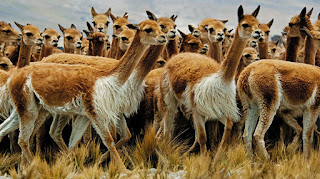Reconsidering the domestication of South American camelids in the South-Central Andes in light of the animal-human relationship in the environment
Domestication has been a topic that has taken great relevance in many areas of study, being the focus of a wide range of multidisciplinary research that occupies the physical, biological and social sciences (Zeder, 2015). With regard to archeology, the study of domestication has gained strength due to the multitude of aspects that come into play, such as cultural, political and social, highlighting the economic field (Yacobaccio and Korstanje, 2007, Yacobaccio and Vilá, 2013). However, domestication has been viewed from an anthropocentric position, approaching the unilateral conception of human action on animals (Tuan, 1984, Hodder, 1990, cited in Dransart, 1990 and Ervynck, A. et al., In Zeder, 2015). These glances can be aligned through the point raised by Marx when he says that "animals and plants, which are usually considered as natural products (...) are (...) the product of a transformation process (...) ), subject to human control and mediated by work "(2008: 220), adding that in the old human caves, tools are found next to the domesticated animal, which" plays the main role as a means of work (...) raised for that purpose, and therefore already modified by work "(2008: 218).
Due to the limitation of these positions, archeology and related disciplines have had to expand their visions to produce a better understanding and explanation of these processes. This is how we can find different edges from which we have tried to study the domestication of animals, in which we can see, thanks to the compilation of Zeder (2015), different definitions of domestication according to certain investigative lines, the main ones being: domestication defined from the perspective of the domesticator, emphasizing in his agency as a selector and assuming his mastery over another species; domestication as a symbiotic and mutualistic relationship; and, finally, domestication seen only as a cultural control, an approach that seeks to break with the traditional vision.
In archeology, the domestication of animals, referring specifically to the domestication of camelids by pre-Hispanic Andean human groups, has traditionally been seen as a transition in human society or as a great economic change (Yacobaccio and Vilá, 2013), in where there is a greater inclusion of resources, which leads to a diversification of the economic niches (López and Restifo, 2014). In this context, the study of domestication has occurred almost exclusively from the gaze of the domesticator and its benefit, considering only its agency and dominating role. However, for purposes of archaeological studies of the domestication of camelids in the pre-Hispanic groups of the Central-South Andes, it is proposed that, as a thesis, an understanding of the relationship of domestication that includes both the actions of animals and the of human under environmental conditions, it would be necessary for a more successful archaeological work; that is, in other words, that a broader view within the archaeological study, which introduces the relationships between human and animal in the environment, including ethnographic research, ethological studies of camelids and archaeological, archaeofaunal, archaeobotanical and paleoclimatic evidences, would be necessary for a comprehensive study that explains the domestication mechanisms of camelids in the south-central Andes, bringing research closer to a better and more accurate understanding of the processes of prehispanic groups in this territory.
The theoric discussion of South American domestication shows the importance of this topic in the archaeological field considering it as an indicator of transition in human society. Thus, camelids become a list of uses for the economy and subsistence, which makes them practically tools. However, to understand and explain the process, we must bear in mind that the relationship between camelids and humans was complex, being necessary to consider a series of stages where both parts act conditioning each other.
The theoric discussion of South American domestication shows the importance of this topic in the archaeological field considering it as an indicator of transition in human society. Thus, camelids become a list of uses for the economy and subsistence, which makes them practically tools. However, to understand and explain the process, we must bear in mind that the relationship between camelids and humans was complex, being necessary to consider a series of stages where both parts act conditioning each other.

Comentarios
Publicar un comentario